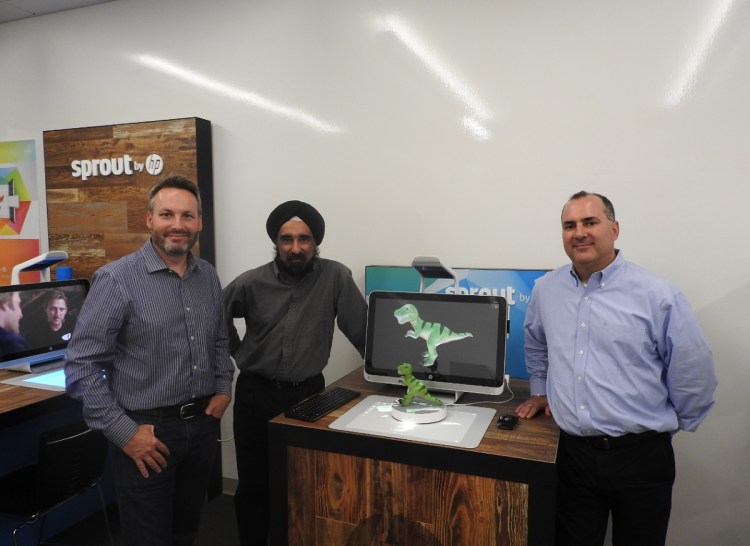Hands-on with 3D scanning
The Sprout team did a live demo for me, scanning in a toy dinosaur. They laid a green dinosaur on top of the HP 3D Capture Stage, which began to spin around slowly. Light from the camera at the top shone down on the object. An image of the dinosaur began to appear on the screen. The software captured the dinosaur’s image in slices, like a pie. Each slice took a few minutes to scan and materialize on the screen. After that, the software can take the pieces of the pie and stitch an image together.
Once the scan is done, the object becomes a file that you can view and manipulate. You can add your own effects to it or create overlays. You can change the material that it is made of, from wood blocks to plastic. And then you can send it off to a 3D printer. You can send it to a professional service that can mail the object back to you in about five days. Or you can send it to the Dremel printer for instant gratification, or, in this case, a plastic replica that takes a few hours to print. The Dremel printer is pretty easy to use. While it isn’t the fastest or most precise piece of equipment, it gets the job done.
Then, once your object is printed, you can hand-paint it to give it the final touches. Here’s a video of how that process works.
The HP team also demonstrated how an advanced user can scan in an object more quickly. They can scan parts of an object and cut some corners, resulting in an image in a shorter amount of time. Here’s a video of the accelerated process.
All the things you can create
HP has created an app ecosystem that other developers can contribute to. HP recently announced seven new applications, including Crayola Color Alive, Ideum Origami Apprentice, Mobile5 SizeUp, Mischief for Sprout, Sprout Stop Motion, Sprout Light Stencil, and Sprout Video Capture. The Crayola app lets kids go nuts with coloring tools in conjunction with selfies.
The Origami app lets kids figure out how to fold origami models via 3D visualization. You put paper on the Sprout’s surface mat and then go step by step through the folds while the upper screen provides animated and verbal instructions.
The Mobile5 SizeUp app lets you measure objects in real time using Sprout’s downward-facing camera. The measurements are projected on the mat overlaying the real object and shown on the vertical screen. It can instantly convert from metric to imperial systems or other units.
Mischief for Sprout lets you sketch objects and import 2D images via the overhead camera. Sprout Stop Motion lets you easily create stop-motion movies. You do so by putting real objects against digital backgrounds, and then mix them up using screen captures and editing tools. You can add sound via a microphone or import audio files.
The Sprout Light Pencil lets users trace, etch, or stencil onto physical objects using an image or design of their own creation. The app projects the image to the horizontal mat, and then the user can apply effects. You can trace, etch, or stencil the project image onto a preferred material, such as a wooden block, T-shirt, leather, or even a cake.
Lastly, the Sprout Video Capture lets you record video content from multiple cameras. You can trim and create multi-shot videos that can share instructions, projects, presentations, or special moments.
“Up until now, we had constraints from technology on how we could think,” said Gurdave Ahluwalia, ecosystem and partner strategist for Immersive Computing at HP, in an interview. “This allows us to change the equation around. Technology is now working for us, in terms of thinking in a 3D world.”
The promise of the future
Sprout can be used for collaboration, direct content transfer and manipulation, instant annotation and capture, 3D snapshots, and augmented reality. You can easily comment on your scanned creations and share them to social networks. Those who receive your 3D objects can view and manipulate them using an online 3D viewer, which allows them to rotate or resize an object to see it from multiple perspectives.
It will still be a while before you can instantly scan and print something that has the highest quality. There are other technologies still to come, such as those for virtual reality, that are likely to be part of the gadgetry needed to complete the vision of immersive computing and blended reality.
But it looks like the technology will eventually get there. And when it does, it will truly be amazing for artists, toy designers, product designers, architects, crafters, makers, engineers, archivists, museum curators, librarians, collectors, and creators of all kinds.
“[This technology will benefit] anybody with a creative thought, whether its parents with children, or teachers with students, or creative workers who want to do something at home,” said Ahluwalia.
One of these days, the scanning and printing processes will be almost instantaneous.
“The speeds are getting shorter, the quality is getting better,” Monsef said. “The materials are getting better, and the printers are getting cheaper.”
“3D printing is in its infancy, like 2D printing was 20 years ago,” Short added. “In the next five years, we’ll see a lot of improvements.”
Rather than printing toys that somebody else has made, some of the best uses of the technology are to create something that couldn’t have been done otherwise, or just would have been too expensive. People used to get baby shoes set in bronze to preserve special memories. But that was expensive. You can do that quite easily today using a 3D printer.






